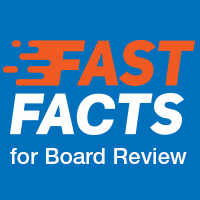User login
Review the PDF of the fact sheet on eye findings in dermatologic conditions with board-relevant, easy-to-review material. This month's fact sheet will review ophthalmologic findings associated with inherited dermatologic conditions.
Practice Questions
1. Which type of EDS is most characteristically associated with blue sclerae and globe rupture?
a. arthrochalasia
b. classical
c. dermatosparaxis
d. hypermobility
e. kyphoscoliosis
2. Ankyloblepharon may be associated with mutation of which gene?
a. fibrillin 1
b. LMX1B
c. NF1
d. p53
e. p63
3. Which is a characteristic ocular tumor in patients with tuberous sclerosis complex?
a. congenital hypertrophy of retinal pigment epithelium
b. phakoma
c. pigmented iris hamartoma
d. pinguecula
e. pterygium
4. Which syndrome is not associated with blue sclerae?
a. EDS type 6
b. lipoid proteinosis
c. Marfan syndrome
d. osteogenesis imperfecta type II
e. pseudoxanthoma elasticum
5. Which term describes white spots at the periphery of the iris?
a. Brushfield spots
b. coloboma
c. Kayser-Fleischer rings
d. Lester iris
e. Lisch nodules
Answers to practice questions provided on next page
Practice Question Answers
1. Which type of EDS is most characteristically associated with blue sclerae and globe rupture?
a. arthrochalasia
b. classical
c. dermatosparaxis
d. hypermobility
e. kyphoscoliosis
2. Ankyloblepharon may be associated with mutation of which gene?
a. fibrillin 1
b. LMX1B
c. NF1
d. p53
e. p63
3. Which is a characteristic ocular tumor in patients with tuberous sclerosis complex?
a. congenital hypertrophy of retinal pigment epithelium
b. phakoma
c. pigmented iris hamartoma
d. pinguecula
e. pterygium
4. Which syndrome is not associated with blue sclerae?
a. EDS type 6
b. lipoid proteinosis
c. Marfan syndrome
d. osteogenesis imperfecta type II
e. pseudoxanthoma elasticum
5. Which term describes white spots at the periphery of the iris?
a. Brushfield spots
b. coloboma
c. Kayser-Fleischer rings
d. Lester iris
e. Lisch nodules
Review the PDF of the fact sheet on eye findings in dermatologic conditions with board-relevant, easy-to-review material. This month's fact sheet will review ophthalmologic findings associated with inherited dermatologic conditions.
Practice Questions
1. Which type of EDS is most characteristically associated with blue sclerae and globe rupture?
a. arthrochalasia
b. classical
c. dermatosparaxis
d. hypermobility
e. kyphoscoliosis
2. Ankyloblepharon may be associated with mutation of which gene?
a. fibrillin 1
b. LMX1B
c. NF1
d. p53
e. p63
3. Which is a characteristic ocular tumor in patients with tuberous sclerosis complex?
a. congenital hypertrophy of retinal pigment epithelium
b. phakoma
c. pigmented iris hamartoma
d. pinguecula
e. pterygium
4. Which syndrome is not associated with blue sclerae?
a. EDS type 6
b. lipoid proteinosis
c. Marfan syndrome
d. osteogenesis imperfecta type II
e. pseudoxanthoma elasticum
5. Which term describes white spots at the periphery of the iris?
a. Brushfield spots
b. coloboma
c. Kayser-Fleischer rings
d. Lester iris
e. Lisch nodules
Answers to practice questions provided on next page
Practice Question Answers
1. Which type of EDS is most characteristically associated with blue sclerae and globe rupture?
a. arthrochalasia
b. classical
c. dermatosparaxis
d. hypermobility
e. kyphoscoliosis
2. Ankyloblepharon may be associated with mutation of which gene?
a. fibrillin 1
b. LMX1B
c. NF1
d. p53
e. p63
3. Which is a characteristic ocular tumor in patients with tuberous sclerosis complex?
a. congenital hypertrophy of retinal pigment epithelium
b. phakoma
c. pigmented iris hamartoma
d. pinguecula
e. pterygium
4. Which syndrome is not associated with blue sclerae?
a. EDS type 6
b. lipoid proteinosis
c. Marfan syndrome
d. osteogenesis imperfecta type II
e. pseudoxanthoma elasticum
5. Which term describes white spots at the periphery of the iris?
a. Brushfield spots
b. coloboma
c. Kayser-Fleischer rings
d. Lester iris
e. Lisch nodules
Review the PDF of the fact sheet on eye findings in dermatologic conditions with board-relevant, easy-to-review material. This month's fact sheet will review ophthalmologic findings associated with inherited dermatologic conditions.
Practice Questions
1. Which type of EDS is most characteristically associated with blue sclerae and globe rupture?
a. arthrochalasia
b. classical
c. dermatosparaxis
d. hypermobility
e. kyphoscoliosis
2. Ankyloblepharon may be associated with mutation of which gene?
a. fibrillin 1
b. LMX1B
c. NF1
d. p53
e. p63
3. Which is a characteristic ocular tumor in patients with tuberous sclerosis complex?
a. congenital hypertrophy of retinal pigment epithelium
b. phakoma
c. pigmented iris hamartoma
d. pinguecula
e. pterygium
4. Which syndrome is not associated with blue sclerae?
a. EDS type 6
b. lipoid proteinosis
c. Marfan syndrome
d. osteogenesis imperfecta type II
e. pseudoxanthoma elasticum
5. Which term describes white spots at the periphery of the iris?
a. Brushfield spots
b. coloboma
c. Kayser-Fleischer rings
d. Lester iris
e. Lisch nodules
Answers to practice questions provided on next page
Practice Question Answers
1. Which type of EDS is most characteristically associated with blue sclerae and globe rupture?
a. arthrochalasia
b. classical
c. dermatosparaxis
d. hypermobility
e. kyphoscoliosis
2. Ankyloblepharon may be associated with mutation of which gene?
a. fibrillin 1
b. LMX1B
c. NF1
d. p53
e. p63
3. Which is a characteristic ocular tumor in patients with tuberous sclerosis complex?
a. congenital hypertrophy of retinal pigment epithelium
b. phakoma
c. pigmented iris hamartoma
d. pinguecula
e. pterygium
4. Which syndrome is not associated with blue sclerae?
a. EDS type 6
b. lipoid proteinosis
c. Marfan syndrome
d. osteogenesis imperfecta type II
e. pseudoxanthoma elasticum
5. Which term describes white spots at the periphery of the iris?
a. Brushfield spots
b. coloboma
c. Kayser-Fleischer rings
d. Lester iris
e. Lisch nodules

